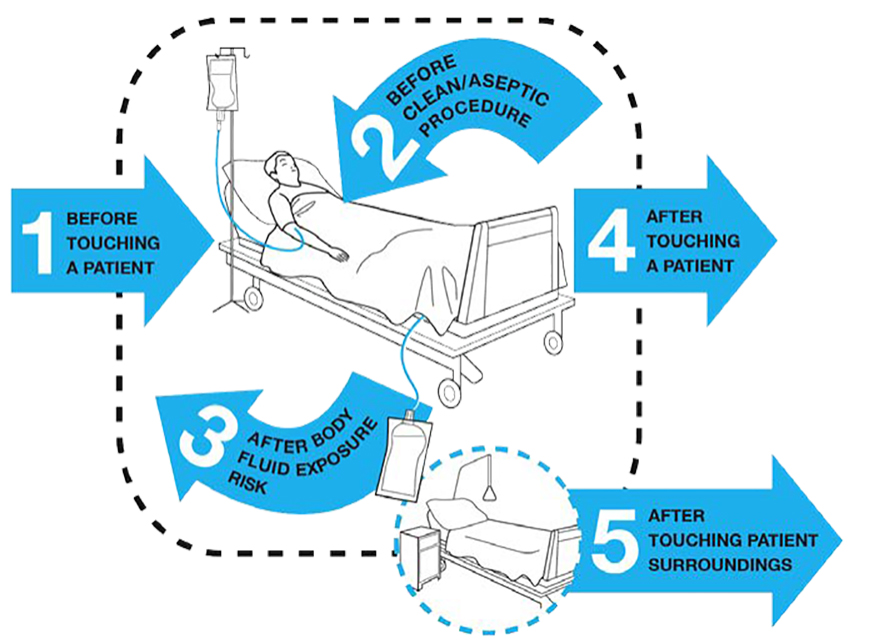Hand hygiene is, of course, a well-established healthcare essential, and one of the keys to keeping healthcare staff safe at work during COVID-19. With healthcare workers (HCWs) facing unprecedented time demands providing care, it may not, however, be realistic to expect them to maintain a sufficient clean-hands regimen without special assistance. Fortunately, there are a range of simple-to-sophisticated hand-hygiene improvements available to healthcare managers.
Being safe at work means keeping sanitizer closer at hand
In 2016, a study released in conjunction with World Hand Hygiene Day showed that by improving both the number and placement of hand sanitizer dispensers, healthcare facilities can boost staff compliance with hand hygiene standards by as much as 50%. Importantly, the research found that not only the quantity of dispensers made a difference, but even more so the context and convenience of their placement, especially in:
Hospital entrances: for better hand hygiene from the start
Whether as individuals coming to see patients or vendors arriving to provide services, visitors to healthcare facilities are typically focused on other things besides clean hands. Therefore, keeping hand sanitizer dispensers highly visible in high traffic areas – such as free-standing, upright dispensers at all entryways – will help ensure that hands are disinfected as soon as new arrivals appear. You and your visitors will also benefit if you provide communication and education on or alongside the dispenser, to encourage use.

Private patient rooms: give hand hygiene the spotlight
Hand sanitizer is one of the most common supplies found in patient rooms; it is also common to find it out of sight or out of reach. Audit your rooms for sanitizer placement, ensuring that dispensers are well within sight of all who enter, not concealed behind a door or curtains, and not blocked from easy access by furniture or equipment in the room.

Semi-private patient rooms: multiply the effect of hand sanitizers
The private room rationale applies here, with the additional consideration of needing at least one dispenser for each bed in the room. The less a doctor, nurse or assistant has to move to reach the sanitizer, the more likely they are to use it.

Nurse stations: take care of the caregivers
No one in a hospital or skilled care facility is in greater or more frequent need of good hand hygiene than a nurse. This means that nursing stations can either be wonderful places of infection prevention or regrettable hubs of infection spread. To make sure your nursing stations are the former, place hand sanitizers on and around the station, and in the corridors leading to it.

Corridors: stay on the path to more effective hand hygiene
Viruses such as COVID-19 tend to travel; in a hospital setting, that means your hallways become highways for spreading disease. You can help break that chain of infection by using corridors as convenient locations for dispensers of hand sanitizer. Here again, signage can remind workers of the need to always keep their hands clean, prompting more frequent usage.
Better hand hygiene also requires better training
While most healthcare workers are well-aware of the need for hand hygiene, 25% of U.S. HCWs are unsure whether their own hand hygiene lives up to guidelines, according to research conducted in 2018 by United Minds. That same study found that 80% of HCWs want to have better training made available to them, with traditional training seen as too boring and passive. To meet this need for enhanced learning, new, technology-driven solutions are being employed, such as the Tork Virtual Reality (VR) Clean Hands Training and Education app.

Rather than study the principles of hand hygiene in a book or classroom, the app allows HCWs to practice them as they don the VR headset and play the role of a nurse or physician in a virtual ward. They work through a series of real-life situations and get hands-on experience with each of the World Health Organizations 5 moments for hand hygiene. This immersive, game-based simulation makes the learning more engaging, and also up to nine times more memorable than text-based lessons, according to the Cone of Experience theory developed by Edgar Dale of Ohio State University. Download the app for free at the Apple AppStore and at GooglePlay, for Android phones.
Get more ideas for improving hand hygiene
Improved dispenser placement and VR hand hygiene training are just two ways to help boost the compliance with and efficacy of hand hygiene in your facility. For more ideas, download the free resource “Safe at Work: COVID-19 Healthcare Toolkit,” created by the global hand hygiene experts at Tork.
Sources:
CDC: Clean Hands Count for Safe Healthcare
Infection Control Today: Strategic Dispenser Placement is Important for Hand Hygiene in Hospitals
Journal of Hospital Infection: Hand hygiene and the novel coronavirus pandemic: the role of healthcare workers
NIH: Clinical Center News
OSU Faculty Bios: Edgar Dale
ResearchGate.net: Cone of Experience
Tork: Improve Your Hand Hygiene in Virtual Reality
Tork: Safe at Work: COVID-19 Healthcare Toolkit
